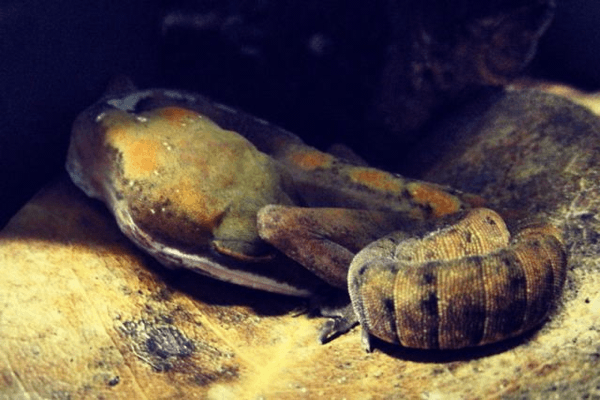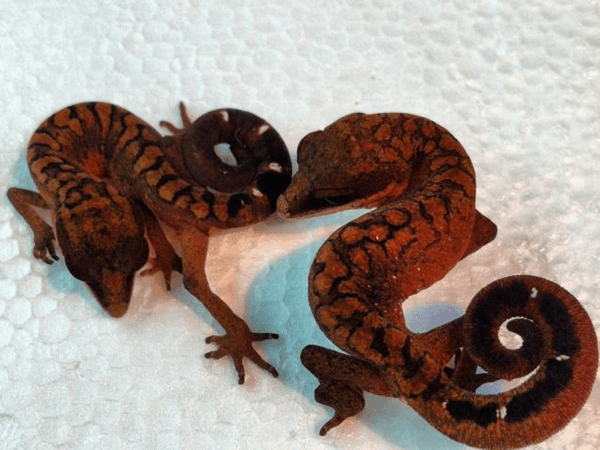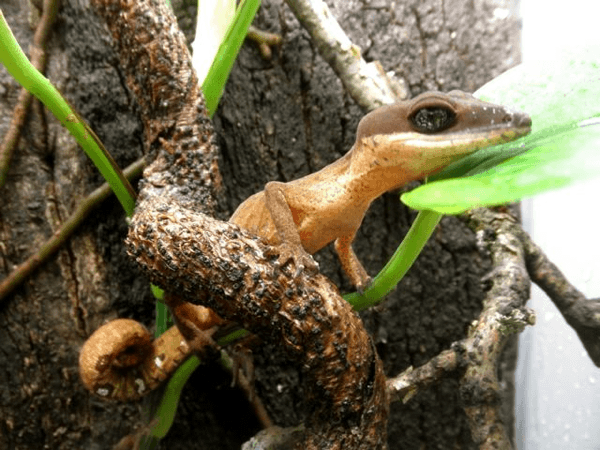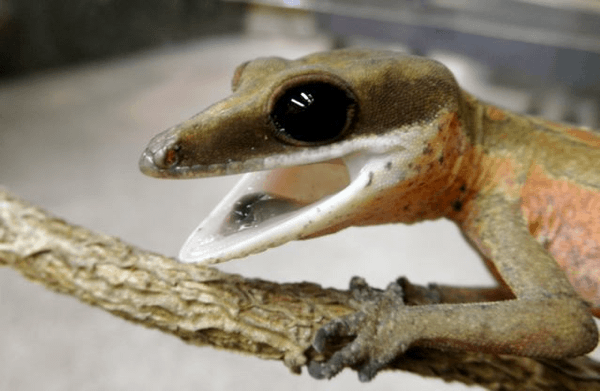Despite a rather controversial April Fool’s article, there really is a gecko genus commonly known as the “cat gecko”. As you will discover below, these geckos are unusual in their appearance as well as in the way they move. As usual, the three cat gecko keepers have responded to the following questions:
1. What species or morphs are you keeping?
2. What got you interested in this species and where did you get your first one(s)?
3. How are they set up? Describe your enclosure
4. What do you find most interesting about them?
5. What do you find to be the biggest challenge?

Kai-Uwe Volta
At the moment I keep Aeluroscalabotes felinus “locality unknown”, as well as Aeluroscalabotes felinus from the “Cameron Highland” “Johor” and “Borneo” locales.
I’ve been interested in Aeluroscalabotes since 2008, when I saw some animals at a German reptile show. But everybody told me that this species is quite difficult to keep and breed, so I worked with other gecko species first to get some experience. In 2010 I couldn’t wait any longer and so I bought a group of Aeluroscalabotes felinus “locality unknown” from a German breeder. After a few months I could say: Keeping Aeluroscalabotes is easy! Three months after I acquired my geckos I got my first eggs, but I had a lot of problems with the incubation; all the eggs went bad in the first weeks. I tried some different things and after a few months the hatch rate increased to 60%. In 2011 I wanted some more of these geckos and finally I acquired a young group of Aeluroscalabotes felinus “Cameron Highland” from a French breeder. I got my first Aeluroscalabotes dorsalis from my good friend Michaels Steffens (Germany) in 2012 and I was so happy about this, because they are so rare in captivity. This year I bought a couple of young Aeluroscalabotes felinus “Johor” from my friend Philipp Höhne (Germany) and a bigger group of Aeluroscalabotes felinus “locality unknown” from a German breeder in Hamm. Actually I keep more than 20 Aeluroscalabotes and I hope that I can get a lot more and breed all the different species and localities in the near future.
I keep my males separated from the females and put them together only for three months of the year. During this time they will mate by themselves. I keep the males in 40x30x30 cm (15x11x11 inch) vivariums and the females in 55x45x55 cm (22x18x22 inch) for one and 80x40x50 cm (32x16x20 inch) for two females. The best temperatures for keeping cat geckos are 24-28°C (75-82°F) in the daytime and 19-22°C (66-72°F) at night-time, so you only need T8 or T5 fluorescence tubes for lighting. In the summer I keep the light on for 14 hours and in the winter for 10 hours a day. Cat geckos are good climbers, so you have to put a lot of thin branches inside the vivarium. Epipremnum sp., Ficus sp. and Scindapsus sp. are perfect living plants for Aeluroscalabotes, because they have big leaves and thin branches. The substrate is a mix of peat and sand (50:50), because it preserves the humidity well. I spray two times a day in the summer and once a day in the winter to maintain a humidity of 65-80% during the day and more than 90% at night. I feed my geckos with all types of insects including cockroaches, crickets, etc. and snails (especially for the gravid females). I keep the hatchlings in 20x20x20 cm (8x8x8 inch) boxes with paper towel on the ground, some thin branches and a moist hiding place. After 6-8 weeks I put the hatchlings in 30x20x20 cm (12x8x8 inch) boxes with the same type of set-up as the males.
The most interesting thing for me about these geckos is their behavior. They are so different from other geckos. The movement of Aeluroscalabotes looks like the movements of cats. Cat geckos generally remain hidden and I’m so happy every time I have the chance to observe them. In all the time I’ve kept them I have only seen them hunting a few times.
The biggest challenge for me is the incubation of the eggs. It’s too bad that they lay only six clutches a year, so you haven’t many eggs for incubation. I tried many different ways before I found the best method. Now I use Perlite and mix it with water (1:1 by weight), put the eggs halfway into the Perlite and leave them alone! I think the most important thing is: Don´t touch the eggs! I have a hatch rate of more than 90% now. I don’t put the eggs in the incubator, I keep them on the top of the vivaria. The boxes have temperatures of 23-27°C (73-81°F) during the day and 18-22 °C (64-72°F) at night. They usually hatch in 110-140 days.

Julie Gibson
Cat geckos (Aeluroscalabotes felinus) do not have morphs, however there are different locales and undescribed species. The locales we keep are Borneo cat geckos (A. f. ‘dorsalis’), also known as Borneo green eyed and Borneo striped cat geckos; and also Johor silver eyed cat geckos (A. felinus).
For us cat geckos are fascinating, so different from any other gecko species and also very beautiful. They were a dream gecko of ours for a long time and we jumped at the chance to own them when the opportunity arose. We acquired our first cat geckos back in 2006. These were Cameroon Highland locale A. felinus. We later got Johor and Borneo cats and we have recently had success breeding both locales.
We house our cat geckos in glass vivariums with fully vented lids. They are kept on a peat, top soil and organic compost mix with leaf litter and moss on the floor. We have climbing branches and twigs, silk and live plants including ficus, dracaena and fern sp. We supply ours with 5% uvb lighting which is available 12 hours a day. We do not use any additional heating for ours as the room temperature and uvb lighting raise the temperatures enough for this species.
We find the way they move and their general behaviour really interesting, they are slow and graceful in their movement, even when feeding.
Breeding, incubating eggs and raising hatchlings are all very challenging in this species. They are a species that stresses easily and everything has to be right before they will breed.

Tom Wood
I am working with three specific locales of “Cat Gecko”. Currently there is debate as to whether animals from different collection sites may be subspecies or truly separate species. The genus Aeluroscalabotes is certainly in need of much taxonomic study and revision.
For this article, I will state that I am keeping Aeluroscalabotes felinus from the montane rain forests of the “Cameron Highlands” region and the “Silver Eyed” A. felinus from the warmer, lower elevations of Johor, Malaysia.
I also keep a sizable group of “Green Eyed Cat Gecko” Aeluroscalabotes “aff” dorsalis which were collected in Borneo. It is my belief that, at the least, A. “aff” dorsalis should be considered a different species than A. felinus.
I first saw “Cat Geckos” on an import list faxed to a reptile specialty shop I was working at in the early ’90’s. The internet was in its infancy, and the species was almost non-existent in literature. . . always curious, I ordered four of these “new” geckos in.
Upon opening the box, 2 were living, 2 had died in transit. The survivors had such an unusual, “sleepy” appearance and moved in a slow, calculated manner, undulating their bodies as they moved. I was immediately intrigued by these bizarre geckos. Knowing so little back then, I housed them rather incorrectly with a heat lamp, and a couple of hides. They did not live long.
Years later, information and photos of cat geckos became slightly more available. Both Dactylus magazine and the “Geckos Unlimited” online forum provided invaluable knowledge first on A. felinus, and later, the newly discovered A. “aff” dorsalis.
When the opportunity arose to purchase a small group of A. felinus F1’s in 2002, I eagerly sent a money order for 6 unsexed. I was blown away at the health, vigor and color of these captive bred babies. I raised the juveniles up, and eventually hatched another generation before trading off the group.
In 2012, I managed to find some of the newer described “dorsalis” Cat Geckos and had a small group to build up. Then, a fellow hobbyist offered me a large breeding group of all three locales, including the ultra rare Silver Eyed Cats. Despite the hefty asking price, I decided to get back into this genus with full force.
Naturalistic enclosures are almost a must for this genus. They are secretive, and need to feel secure in order to thrive.
I keep them singly, or in 1.1 pairs in 12x12x18 vertically oriented glass enclosures. I use a layer of LECA “Hydroton” balls as a drainage layer, covered with a sheet of landscape fabric. On top of this, my version of ABG substrate is placed to a depth of about two inches. Several thin branches and a live Pothos vine provide ample climbing structure for these surprisingly arboreal captives. Lacking adhesive lamellae, glass is not climbable to these geckos, but their clawed toes utilize other surfaces with ease. They are often found at the tops of their Vivaria exploring and hunting.
One important cage furnishing is large dried leaves (tropical Magnolia are my favorite) as a floor covering. This “leaf litter” layer is almost always utilized by all three cat gecko types as day-time hides.
A nightly drenching is always appreciated by these animals, replicating their rainforest habitats. Misting heavily each night brings the geckos out to prowl and drink droplets. Reverse osmosis water is always used on the collection, minimizing unsightly water spots on enclosure walls, and mimicking pure rain water.

There are claims of mineral sensitivity in the genus, so supplementation is very light. I dust prey items very lightly with Miner-all only once a month or so. They are very effective hunters, despite their slow methodical approach. Only two or three appropriately sized insects or isopods are offered every other night. Introducing too many feeders at a time are very stressful to these geckos. Uneaten prey should be removed in the morning if possible.
I keep all three forms at the same temperatures with no problem. Extremes are avoided. Day time highs are in the low to mid 80’s F. and drift down to the mid 60’s F. nightly.
Juveniles are set up in smaller versions of similar above mentioned enclosures singly or as clutch mates, with few husbandry issues.
What I find most interesting about them is a hard question to answer, lol.
They are certainly unique geckos, all the way around. I have read that cat geckos are thought to be the most primitive of living gecko species, so they provide a glimpse back in time as to what the first Eublepharids (eyelid geckos) were like on earth.
Their sleeping method of curling up like a cat and “sleepy” look are certainly endearing. The range of colors and patterns are beautiful, their eyes are mesmerizing. Their cat-like hunting and stalking behaviors are awesome. Much of their natural history is unknown.
One perplexing thing within this genus is the deposition of “mineral deposits” that the geckos excrete. These pure white, irregularly shaped “rocks” are found in both adult and juvenile enclosures of all three Cat Gecko types, regardless of supplementation regime. To my knowledge, no real explanation for these deposits has been given.
Overall, I have found Aeluroscalabotes spp. to be rather undemanding captives, if their needs are met. Of course, Captive Bred animals are the way to go, as imports are inevitably dehydrated and stressed from shipping. Malaysia seems to be shutting down reptile exports more and more each year, and natural habitat is shrinking at an alarming rate, so it is vital to establish the genus in herpetoculture.
The “Johor Silver Eyed” form has proven more challenging for me to hatch consistently in the short time I’ve had the privilege to own them. Infertility is higher than the other forms, as is neonate mortality. Hopefully, the 2014 season and beyond will produce more consistent, positive results for myself and the few that are keeping them in captivity.
Another challenge with any species in the genus is finding other dedicated keepers to compare notes with and trade offspring with.
I am certain that these amazing geckos are going to skyrocket in popularity as more people discover just how beautiful and unusual these “Cat Geckos” are. They deserve a spot in any serious geckophile’s collection.
Julie and Lauren Gibson are mother and daughter and keen gecko keepers based in the UK. They own a variety of species including Uroplatus, Rhacodactylus, Correlophus and Aeluroscalabotes. They have a website – www.rhac-shack.co.uk which gives advice and guidance about the range of species they keep.
Kai-Uwe Volta is 30 years old, father of a three year old daughter and lives in Germany. He worked for more than seven years for the pet industry and at the moment he´s a student of landscape architecture. From his earliest childhood he kept pets. When he was a child he kept birds, mammals and fish. When he got older his interest in reptiles rose more and more and so in 2007 he began to breed geckos only. At the moment he keeps more than 30 geckos (Coleonyx, Eurydactylodes, Aeluroscalabotes, Uroplatus) and some insects (Phillium, etc.).
Thomas Wood has been keeping geckos for almost 30 years. He now maintains a large collection focusing on Rainforest taxa including Uroplatus, Paroedura, Aeluroscalabotes, and other genera. When not tending to the animals or running his aquarium store, The Reef Shoppe, he is an avid Japanese-style gardener and loves to see live music. For more information on what geckos he is working with, follow his Facebook Page: www.facebook.com/SecretLaboratoryGeckos


Just an FYI, Marcus claimed that there was DNA results proving that the Highlands animals and the Johor animals were different. I do not have access to that information so I cannot say definitively or not myself. One other thing of note that seems to be a common mistake is that not all animals from Johor are silver eyes. And not all black eyed animals are from the Highlands. The Johors also seem to tolerate (and even enjoy) higher temps than the Highland animals do.
@Ethan – Thanks so much for the input! Do you have a link to more information or forum post?
Matthew, I’d say that the best places to go online for A. felinus info in general would be the felinus forum on Geckos Unlimited:
http://www.geckosunlimited.com/community/cat-geckos-aeluroscalabotes-felinus-others/
and on my felinus group on Facebook:
https://www.facebook.com/groups/catgeckos/
Both have extensive information on these fantastic animals.
Thanks all of you for these interesting articles about the genus Aeluroscalabotes.